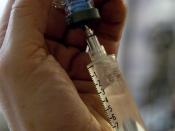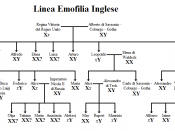Hemophilia Manitoba Hemophilia Manitoba, or hemophilia, is a sex-linked genetic disorder that is effecting about 20,000 Americans, most of which males. A person with hemophilia either has an inactive or inadequate supply of one of several blood factors needed for blood to clot. Because of this hemophilia can be mild, moderate, or severe. Severe hemophiliacs are at risk for bleeding during surgery, trauma, or even dental work. There are two types of hemophilia, A and B (Christmas disease). Hemophilia B is extremely rare. The majority of the people have hemophilia A. In hemophilia A, the particular factor missing is 8 for clotting.
Because hemophilia is sex-linked disorder, it can be passed on from mother to child. This is because the gene responsible for making blood factors 8 and 9 are only found on the X-chromosome. If a female is a carrier that means that she has one bad gene and one good gene for this disease.
There is a fifty percent chance that she would pass it on to her child because she can only pass on one of the two chromosomes. If a male has hemophilia, he will have normal sons and all of his daughters will be carriers of the hemophilia disorder because all he can pass on is the defective X-chromosome.
Males mostly have hemophilia, but women can also have hemophilia. This is extremely rare though because two defective X-chromosomes would be needed. In fact, the first proven case of women having hemophilia was not until the 1950's (Bornstein 89). Female carriers are also at risk. These women are known as asymptomatic carriers and may suffer excessive menstrual bleeding, bruising, nosebleeds, and problems during childbirth.
One serious problem with hemophilia is joint bleeds. When a joint bleeds, a small amount of blood leaks into joint space and can not escape the joint because it is covered by a capsule of tissue. If the bleeding is not discovered by this stage, blood will continue to fill up the joint space. The joint begins to swell and become uncomfortable. Eventually, the pressure inside will be greater than outside and the bleeding stops. Fortunately, the blood makes digestive enzymes that eats up the trapped blood. Unfortunately, the digestive enzymes will also attack the cartilage that covers the bones. After several bleeds, the cartilage can become worn out and the enzymes can eat away at the bone.
Hemophilia is either treated each time an internal bleed occurs or continuously through infusions. An infusion will stop the bleeding, but only for about a day. Therefore, most hemophiliacs infuse on a regular basis. Before 1985, infusions were not screened for viruses. This resulted in a major outbreak of the HIV virus that infected fifty percent of hemophilia patients. Also, hepatitis was transmitted throughout the hemophiliacs. Today, instead of human factor, recombinant DNA factor 8 is used in order to prevent viruses.
People without insurance could not afford hemophilia. An annual bill for hemophilia is usually fifty to a hundred thousand dollars. Each unit for factor 8 is $1.50. In one particular case, surgery cost $500,000 because the patient was given 1,000 units every hour.
Gene therapy treatment can also be used against hemophilia. In-vitro fertilization centers can take an egg and fertilize it by the male sperm on a petri dish. When the egg multiplies 8 times or more, they can remove one cell at a time and analyze its DNA for the genetic mutation. The healthy eggs would then be put into the uterus. The process is especially appropriate for hemophilia B because nearly all mutations causing it can be detected.
One very famous person to have hemophilia was Queen Victoria. Victoria married Prince Henry of Battenberg and they had several children from the marriage. The two sons both acquired the hemophilia gene from their mother and died of the ages twenty and thirty-one.
Victoria's second child, Alice was born in 1843 and married Louis IV, Grand Duke of Hesse-Darmstadt. There were two sons of the marriage, of which one died at the age of three because of hemophilia. There were three daughters of the marriage: Irene, Victoria, and Alice.
Irene, a carrier, passed the gene onto her children with Prince Henry of Prussia. Victoria, not being a carrier, had a grandson who passed a normal blood-clotting gene back into the royal family of England. Alice, a carrier, married Nicholas II, Czar of Russia bringing Queen Victoria's gene into the Russian family. On August 12, 1904 during the middle of the Russo-Japanese War, Alice had a baby boy named Alexis with hemophilia. Alexis's first sign was when the umbilicus was bleeding when he was six weeks old. Soon later, bruises appeared when he would bump into things when crawling. Alice now realized that she had passed on the gene and never fully forgave herself.
Contrary to popular belief, people in this time with hemophilia will not necessarily die or come close to death by minor cuts or injuries, nor do they bleed faster.
However, people with hemophilia do bleed longer. As many as one-third of all new cases of hemophilia occur in families with no previous history of this disorder. The gene causing hemophilia mutates twenty to thirty times per million gametes produced. The causes for mutations are still poorly understood, but it is known that some high- energy chemical and nuclear radiation increases the rate of mutation.
Bibliography Bornstein, Jerry and Sandy. What is Genetics? New York: Julian Messner, 1979.
Cartwright, Frederick F. Disease and History. New York: Dorset Press, 1991.
Zallen, Doris Teichler. Does It Run in the Family. New Brunswick: Rutgers University Press, 1997.
Wingerson, Lois. Mapping Our Genes. New York: Penguin Books, 1990





